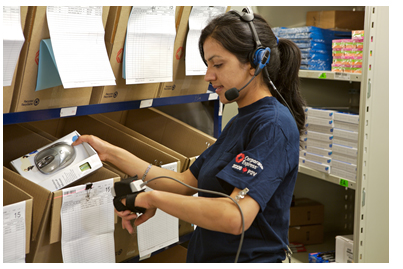Holste Says: |
 |
| Most WMS have task interleaving software capability out of the box, or if not it can be easily added. |
|
What Do You Say?
|
|
|
|
Previous Columns by
Cliff Holste |
|
|
While most small to medium DCs have little or no material handling automation, most have a Warehouse Management System (WMS). In these companies order fulfillment is a manual function performed by employees who are on foot or lift truck using a hand-held RF device connected to the WMS. These companies can enhance their order fulfillment operation by accelerating the performance of their existing ERP/WMS systems. The following are four well established ways to do that:
1. Pick-to-Light & Voice Technologies:
Pick-to-Light and Speaker Independent Voice Picking are proven “hands-free” picking technologies supported by WMS. With pick-to-light order pickers are directed to the required pick location by flashing lights along the shelves that also display the number of units or cases that need to be picked. With voice picking, the order picker is directed by computer voice to the proper location and once there is told how many units or cases to pick. Industry providers report 30% to 75% reduction in labor with 99.9% order picking accuracy.
As a general rule, lights are best in medium to high volume operations and more dense picking areas like case flow racks. Voice may be a better choice for high volume picking from pallet locations and/or slow moving SKUs that are spread out. For some DCs adopting a combination of both technologies will provide the best ROI. 
The most common benefit of hands-free order picking is higher productivity, i.e., the order picker never has to put down (or holster) an RF device (scan gun) to either pick or open cartons. In a voice system the order picker listens to the voice directive while moving to the next location instead of stopping to read the RF device. Industry providers report 30% to 75% reduction in labor with 99.9% order picking accuracy.
However, in some operations an RF combination provides the ability to quickly and accurately capture detailed item information, such as a production batch or serial numbers, more quickly by scanning the items barcode.
Speaker Independent Voice Picking
2. Multi-Modal Technologies:
In recent years multi-modal technologies have emerged as an answer to improving picker productivity with integrated wearable RF devices. While traditional RF devices are limited to one function, an integrated multi-modal solution allows a picker to seamlessly choose between voice, bar code scanning and manual input without having to switch from one software application to another. When equipped with a hands-free 2D camera – rapid item SKU and lot barcode scan verification is fully integrated into the order picking process.
3. Software Applications:
Task interleaving software minimizes the amount of travel between tasks by taking full advantage of serial opportunities rather than being functionally dedicated. However, not everyone uses this functionality because it requires a somewhat different way of working. For example – when a lift truck driver delivers a pallet load of product to picking for replenishment, the next task might be to pick up a stack of empty pallets that are needed in shipping. While in shipping, the next task may be to move a pallet load to the shipping dock or staging area. The idea is to make every move productive. Most WMS have task interleaving software capability out of the box, or if not it can be easily added.
4. Slotting and Labor Management Strategies:
Proper determination of product pick face location is a dynamic and complex issue. Put simply, slotting is the strategy behind determining the best locations to store individual products to enable the most efficient picking. The top performing companies are constantly looking at where their products are stored and what is the best method for picking each SKU.
Slotting tools are available that calculate which items will be picked most frequently and should be in the most advantageous picking position to reduce the amount of travel a picker does to pick the order. In addition, the tool will make obvious recommendations like putting the heaviest items at chest height to avoid back injuries as well as more subtle recommendations to separate similar products/parts to avoid picking errors.
To make the most out of the slotting tool it should be integrated with a labor management system (LMS). A LMS program will calculate the cost of moving the material from one location to another, along with the potential labor savings from more efficient picking so that DC management can determine whether the savings outweighs the cost associated with moving the product.
|